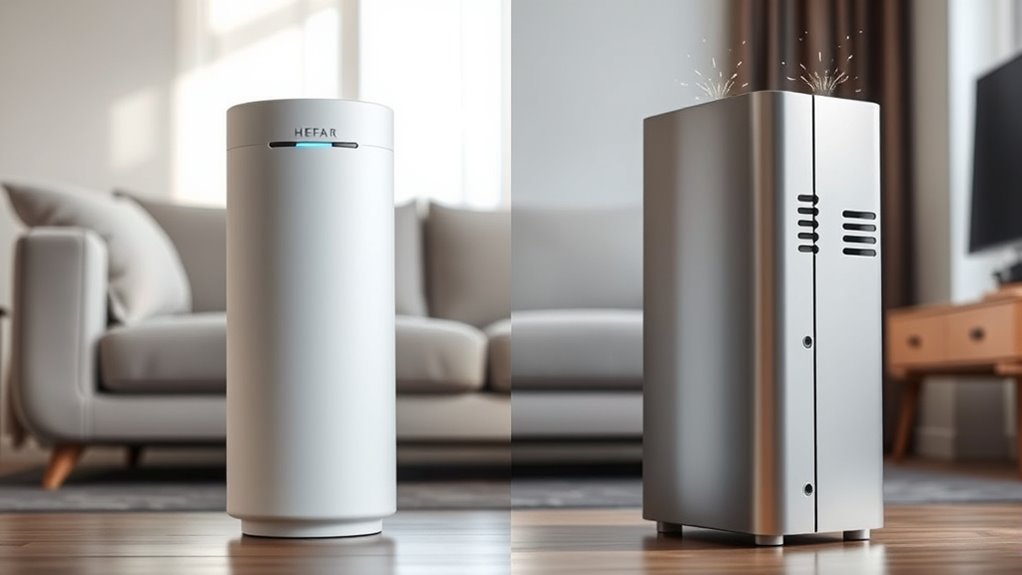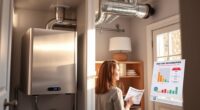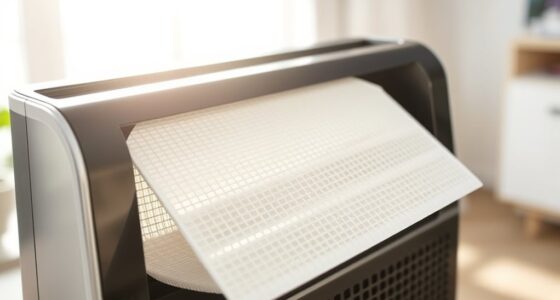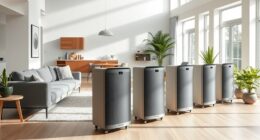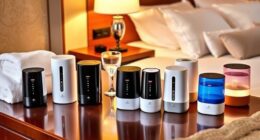HEPA purifiers are generally safer because they physically trap airborne particles like dust, pollen, and germs without producing ozone, which can irritate your lungs. Ionizers also remove particles but can generate ozone as a byproduct, posing health risks especially for sensitive individuals. If you want a safer choice with proven effectiveness, HEPA devices are a better option. To understand the differences more fully, consider exploring how each type works and their long-term impacts.
Key Takeaways
- HEPA purifiers do not emit ozone, making them safer for respiratory health compared to many ionizers.
- Ionizers can produce ozone as a byproduct, which may irritate lungs and exacerbate respiratory issues.
- Proper maintenance of HEPA filters prevents mold and bacteria buildup, ensuring safer indoor air quality.
- Ionizers generally have lower initial costs but may pose health risks due to ozone emissions.
- Regulatory standards are evolving to better control ozone emissions from ionizers, emphasizing safety concerns.
How HEPA Purifiers Capture Airborne Particles

HEPA purifiers work by trapping airborne particles as air passes through a dense filter. As you operate the purifier, it creates specific airflow patterns that draw in contaminated air from your environment. The HEPA filter captures tiny particles like dust, pollen, pet dander, and bacteria with high efficiency. To maintain ideal performance, regular filter maintenance is essential—you should replace or clean the filter according to the manufacturer’s instructions. Proper filter upkeep ensures the airflow remains unobstructed, allowing the purifier to work effectively. Over time, accumulated particles can reduce airflow and filtering capacity, so timely maintenance keeps your air clean. Understanding how airflow patterns and filter care work together helps you maximize the benefits of your HEPA purifier. Additionally, selecting a model with auto functionality can help monitor air quality and optimize filter usage automatically.
The Mechanism Behind Ionizer Air Cleaners
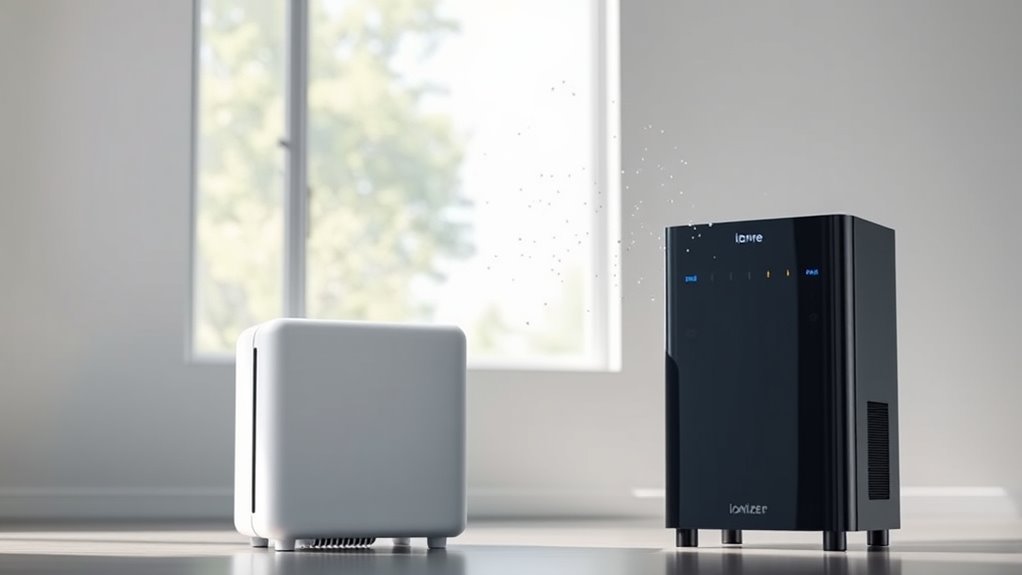
You might wonder how ionizer air cleaners work, so let’s break down the process. They generate charged particles through ionization, which attach to airborne pollutants. This creates charged particles that help remove contaminants from the air efficiently. Additionally, some ionizers incorporate air filtration techniques to further improve air quality.
Ionization Process Explained
Have you ever wondered how ionizer air cleaners work to purify the air around you? It all starts with air ionization, where the device generates a high-voltage electric charge. This process produces charged particles, also known as ions, that are released into the environment. These ions attach to airborne pollutants like dust, pollen, and smoke, causing them to become charged. As a result, these charged particles are attracted to nearby surfaces or collection plates within the device, removing them from the airflow. This ionization process effectively reduces airborne contaminants, improving air quality. Additionally, AI-powered data analytics can be used to optimize the efficiency of air purification systems by monitoring air quality in real time. However, it’s important to understand that while air ionization captures particles, it doesn’t necessarily eliminate all pollutants like bacteria or viruses without additional filtration.
Charged Particles Formation
The process of charged particles formation begins when the ionizer generates a high-voltage electric charge, creating a strong electric field. This electric field causes molecules in the air to gain or lose electrons, producing charged particles. These particles, known as ions, often develop static electricity as they acquire a charge. As a result, the charged particles become attracted to surfaces, walls, or airborne particles, helping them remove contaminants from the air. Static electricity plays a key role in this process, as it enhances the attraction between ions and particles, causing them to clump together or settle out of the air more quickly. This mechanism is fundamental to how ionizer air cleaners work, utilizing charged particles to reduce airborne pollutants efficiently.
Air Purification Mechanics
Ionizer air cleaners work by electrically charging airborne particles, which then helps remove contaminants from the air. When air passes through the device, a high-voltage electric field gives a charge to particles like dust, pollen, and bacteria. These charged particles then either stick to nearby surfaces or are attracted to oppositely charged collection plates, effectively trapping them. This process enhances air purification by reducing indoor pollutants without needing filters. Unlike HEPA filters, ionizers don’t physically trap particles in a filter; instead, they rely on electrostatic attraction. As a result, ionizers can continuously clean the air, but they may also produce ozone as a byproduct, which can impact indoor air quality. Understanding this mechanism helps you evaluate if an ionizer suits your air purification needs. Additionally, the effectiveness of ionizers can vary based on the size of particles and the device’s design, making it important to consider air purification technology when choosing a system.
Effectiveness in Removing Allergens and Pollutants

While both HEPA purifiers and ionizers aim to improve indoor air quality, their effectiveness in removing allergens and pollutants varies. HEPA purifiers excel at capturing tiny particles because of their superior filter material, which is designed to trap 99.97% of particles as small as 0.3 microns. Proper airflow optimization ensures that air passes efficiently through the filter, maximizing removal efficiency. Ionizers, on the other hand, work by charging particles so they settle out of the air or stick to surfaces, but their ability to remove allergens like pollen and dust is less direct. If you want to target airborne pollutants effectively, a HEPA purifier with optimized airflow and high-quality filter material is your best choice. Ionizers may supplement air cleaning but generally aren’t as effective for allergen removal. Effective air filtration relies heavily on both the quality of the filter material and proper airflow management.
Safety Concerns and Potential Health Risks
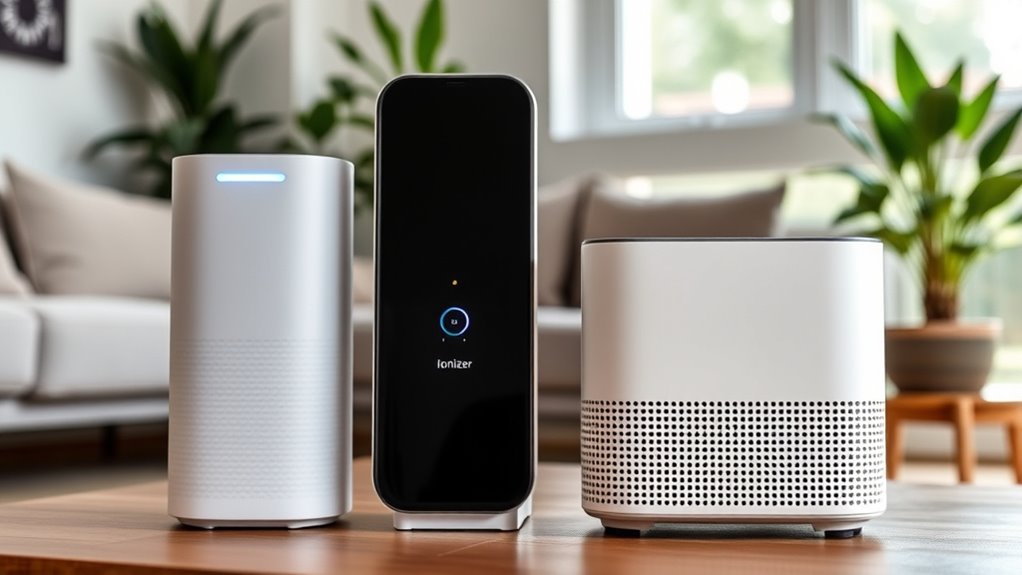
You should be aware that some ionizers produce ozone, which can irritate your lungs and worsen respiratory issues. This ozone emission poses health risks, especially for sensitive individuals. Understanding these safety concerns helps you choose air purifiers that won’t compromise your well-being. Additionally, ongoing research into AI safety measures highlights the importance of implementing robust safety protocols to prevent potential health hazards associated with air purification technologies.
Ozone Emissions and Risks
Although ionizers are effective at reducing airborne particles, they can produce ozone as a byproduct, which raises safety concerns. Ozone emission concerns stem from its potential to cause respiratory issues and other health problems when inhaled in significant amounts. During a health risk assessment, experts evaluate the levels of ozone generated by ionizers and compare them to safety standards set by agencies like the EPA. Even low ozone levels can irritate the lungs, especially for sensitive groups such as children or those with asthma. It’s essential to understand that while ionizers may improve air quality, their ozone emissions could pose a hidden risk. Additionally, the regulatory landscape surrounding these devices is evolving as authorities seek to better understand and control ozone emissions. Carefully consider these ozone emission concerns before choosing an air purifier to ensure your health isn’t compromised.
Respiratory Irritation Concerns
Have you considered how air purifiers might affect your respiratory health? Improper air purifier placement can cause airflow issues, potentially leading to uneven filtration and increased irritation. If a purifier isn’t positioned correctly, it might circulate dust or allergens instead of removing them. Additionally, neglecting filter replacement frequency can worsen this problem. Overused filters can become clogged, releasing trapped particles back into the air and irritating your lungs. HEPA filters, if not maintained, may also harbor mold or bacteria. Ionizers pose a different risk; they can produce ozone, which irritates your respiratory system and aggravates asthma. To reduce health risks, follow manufacturer guidelines for placement and replace filters regularly, ensuring your air purifier genuinely improves your indoor air quality without causing irritation. Proper maintenance and understanding of air purification technologies can help minimize potential health hazards.
Impact on Indoor Air Quality Over Time

Over time, HEPA purifiers and ionizers can substantially influence indoor air quality, but their effects differ in consistency and scope. HEPA purifiers consistently remove airborne particles like dust, pollen, and pet dander, improving air quality reliably. They work best when paired with air quality sensors that help you monitor improvements. Ionizers, on the other hand, can cause particles to settle faster, but their impact varies depending on room conditions. Indoor humidity levels also affect performance; high humidity can reduce ionizer efficiency and promote mold growth, which worsens air quality. While HEPA filters provide steady, measurable improvements, ionizers’ effects can fluctuate, making ongoing monitoring essential. Understanding how each device interacts with your indoor environment helps you make smarter choices for cleaner air over time. Additionally, filter maintenance plays a crucial role in ensuring the continued effectiveness of air purifiers.
Ozone Emissions and Their Health Implications

While both HEPA purifiers and ionizers aim to improve indoor air quality, ionizers can produce ozone as a byproduct, which poses health risks. Ozone safety is a major concern because even low levels can cause respiratory irritation, worsen asthma, and reduce lung function. Inhaling ozone can trigger coughing, chest pain, and throat irritation, especially for sensitive groups like children and allergy sufferers. The health effects of ozone emissions are well-documented, making it essential to consider ozone safety when choosing air purifiers. Unlike HEPA filters, which do not emit ozone, many ionizers generate this harmful gas during operation. Consequently, understanding the potential health effects of ozone emissions is vital to select a safer, healthier air purification option for your home.
Maintenance and Long-Term Use Considerations

Maintaining your air purifier involves keeping up with filter replacements, which can affect both performance and costs over time. You’ll also want to contemplate how much energy it consumes, especially if you plan to run it frequently. Additionally, the device’s durability and lifespan play a key role in your long-term investment. Considering the potential for long-term efficiency can help you choose a device that remains effective over time.
Filter Replacement Schedule
Regularly replacing filters is essential to keep your air purifier functioning effectively and ensuring ideal air quality. The filter lifecycle varies depending on usage, environment, and the model, so paying attention to the recommended replacement frequency is key. Usually, HEPA filters need changing every 6 to 12 months, while ionizer filters may last longer but still require periodic checks. To maximize efficiency, consider these points:
- Monitor filter condition regularly for signs of dirt or clogging
- Follow manufacturer guidelines for replacement intervals
- Replace filters promptly to prevent reduced airflow and performance
- For optimal air purifier performance, adhering to the recommended replacement schedule is crucial.
Neglecting timely replacements can decrease air purifier effectiveness and compromise air quality. Staying on top of your filter schedule ensures your device continues to operate safely and efficiently over the long term.
Energy Consumption Impact
Energy consumption is a key factor to contemplate when choosing between HEPA purifiers and ionizers for long-term use. Your decision should consider each device’s energy efficiency, as it affects ongoing costs and environmental impact. HEPA purifiers generally have higher power consumption because they rely on fans to push air through dense filters, but they tend to be energy-efficient relative to their cleaning capacity. Ionizers typically use less power since they generate ions without needing powerful fans, making them more cost-effective over time. However, their lower power consumption may come with trade-offs in cleaning speed and effectiveness. To make an informed choice, compare the power consumption ratings and assess how each device fits your long-term energy and budget goals. Additionally, advancements in AI-driven solutions could influence future designs, potentially improving energy efficiency further.
Longevity and Durability
When considering longevity and durability, it’s important to understand how each device holds up over time and what maintenance they require. HEPA purifiers typically have a longer filter lifespan, often lasting 6 to 12 months with proper care, but their filter material durability depends on usage and air quality. Ionizers generally have fewer parts to replace, but their internal components may degrade faster due to continuous operation. Additionally, choosing devices with easy-to-maintain components can help extend their effective lifespan.
Cost Differences and Value for Money

While HEPA purifiers often come with a higher upfront cost, they generally offer better long-term value due to their durability and superior filtration capabilities. When doing a cost comparison, it’s clear that HEPA units may require a larger initial investment, but their longer lifespan and effective filtration reduce replacement and maintenance expenses over time. Ionizers tend to be cheaper initially, but they often need more frequent replacements and may generate ongoing costs due to ozone filters or maintenance. For a thorough value assessment, consider not just the purchase price but also the longevity, energy efficiency, and ongoing operational costs. Additionally, HEPA filters are known for their effectiveness against allergens, making them a more reliable choice for improving indoor air quality. Overall, HEPA purifiers tend to deliver greater value for money because they provide reliable, long-lasting air quality improvements without frequent additional expenses.
User Experience and Noise Levels
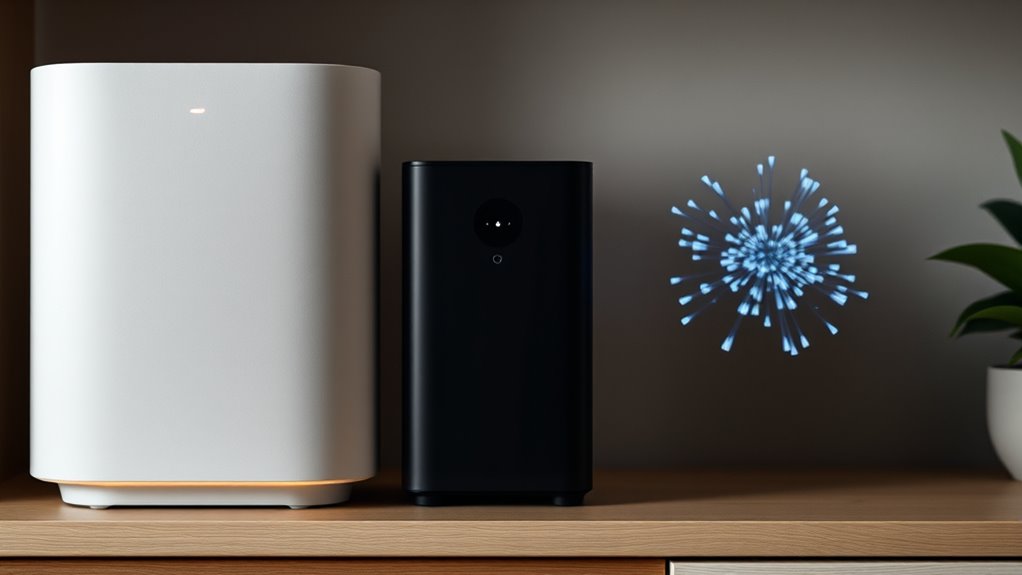
User experience and noise levels play a significant role in choosing between HEPA purifiers and ionizers. Your comfort depends on how quietly these devices operate and how they fit into your daily routine. HEPA purifiers often have fans that generate consistent noise, which can be distracting or disruptive, especially at night. Ionizers, on the other hand, tend to produce less noise, making them suitable for continuous use in quiet environments.
Ionizers operate more quietly, ideal for continuous use in peaceful environments.
- HEPA purifiers may have higher noise levels during operation, affecting user comfort
- Ionizers generally operate more quietly, enhancing user experience
- Consider your sensitivity to sound when selecting a device for your space
Balancing noise levels with performance helps ensure a more satisfying air purification experience.
Making an Informed Choice for Safer Air Purification
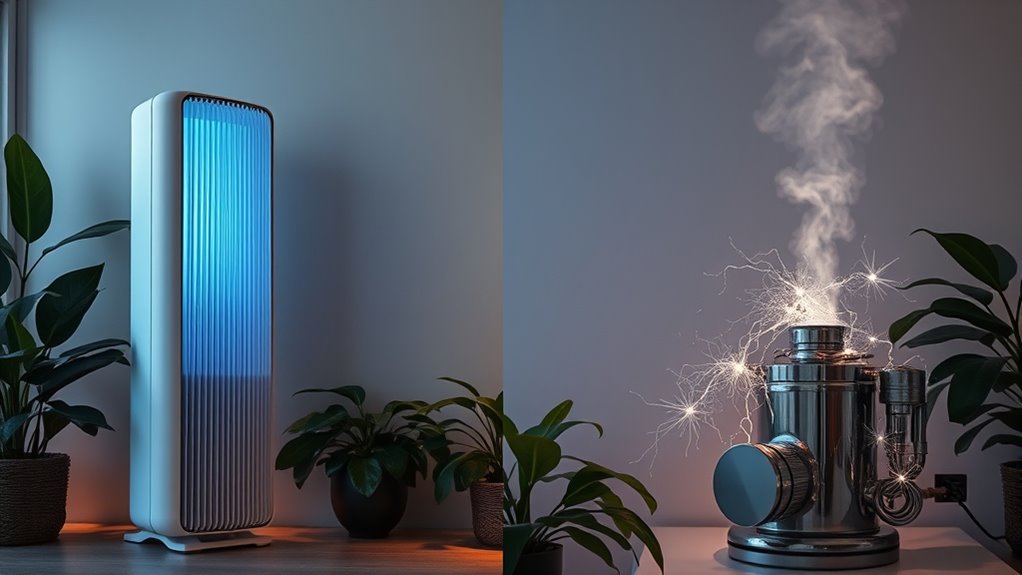
Making an informed choice involves evaluating more than just noise levels and user comfort. To make an informed choice, prioritize air quality testing to understand your home’s specific needs. Regular testing reveals pollutant levels, helping you select devices that effectively target allergens and airborne contaminants. Consider how well the purifier removes allergens, such as pollen, pet dander, and dust mites. HEPA purifiers excel at allergen removal, making them suitable for allergy sufferers, while ionizers may require additional features for thorough air cleaning. Research the purifier’s technology and certifications to ensure safety and effectiveness. Additionally, understanding the filter maintenance requirements and troubleshooting tips can help maintain optimal performance over time. By combining air quality testing with a clear understanding of allergen removal capabilities, you’ll confidently choose a device that safeguards your health and improves your indoor environment.
Frequently Asked Questions
Are HEPA Purifiers Effective Against Viruses and Bacteria?
You’ll find that HEPA purifiers are highly effective for air filtration, especially when it comes to virus removal and bacteria elimination. They trap tiny particles, including airborne viruses and bacteria, making your air safer to breathe. For ideal air purification, choose a HEPA filter certified to meet standards. While no device guarantees complete virus elimination, HEPA purifiers considerably reduce airborne pathogens, improving your overall indoor air quality and health.
Do Ionizers Produce Harmful Ozone Levels in All Settings?
Think of ozone safety like walking a tightrope—you need to measure your balance carefully. Ionizers can produce ozone, but levels vary widely depending on the device and setting. In some cases, ozone measurement shows safe levels, but in others, it can be harmful. Always check ozone levels with an ozone meter, and make certain the device’s ozone output stays within safe limits to protect your air quality and health.
Can HEPA Filters Remove Odors and Chemical Vapors?
Yes, HEPA filters can remove odors and chemical vapors by trapping airborne particles and some VOCs through chemical absorption. While they excel at air freshening by capturing smoke, pet dander, and dust, they’re less effective at completely eliminating strong chemical odors or vapors. For better chemical absorption, consider activated carbon filters alongside HEPA units, which target odors and chemical pollutants effectively to improve your indoor air quality.
How Often Should Filters or Ionizer Components Be Replaced?
Think of your purifier as a loyal garden that needs regular tending. For ideal filter replacement, check the manufacturer’s guidelines—usually every 6 to 12 months—to keep it running smoothly. Ionizer maintenance, on the other hand, involves periodic cleaning of the device’s components to prevent buildup. Regular care ensures your air stays crisp and safe, turning your space into a invigorating breath of fresh air rather than a foggy maze.
Which Device Is Better for Households With Asthma Sufferers?
If you want better air quality improvement and allergen reduction for your household with asthma sufferers, a HEPA purifier is the safer choice. It effectively captures airborne particles like dust, pollen, and pet dander without producing ozone or other potentially harmful byproducts. Ionizers may seem appealing, but they can emit ozone, which can irritate asthma and worsen symptoms. Prioritize HEPA filters for safer, cleaner air.
Conclusion
Ultimately, choosing between HEPA purifiers and ionizers can feel like steering a maze of options. HEPA filters are your trusty shield, capturing almost every airborne villain, while ionizers silently work behind the scenes, but with some safety caveats. Think of it as selecting your perfect air guardian—wise, safe, and effective. Don’t settle for mediocrity; aim for the air quality of a palace—because your health deserves nothing less than the best.
